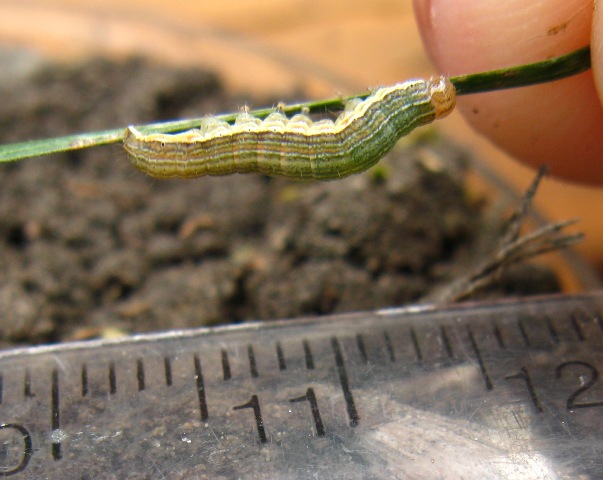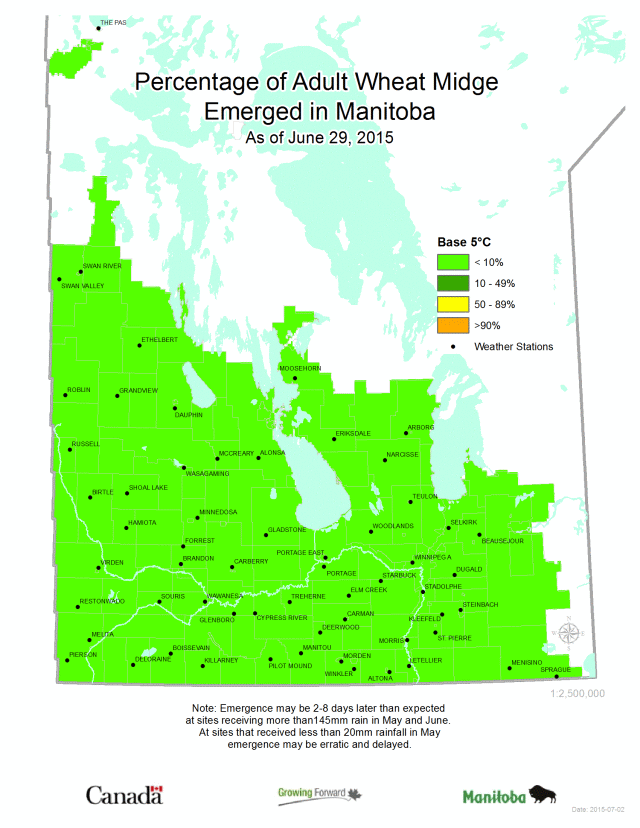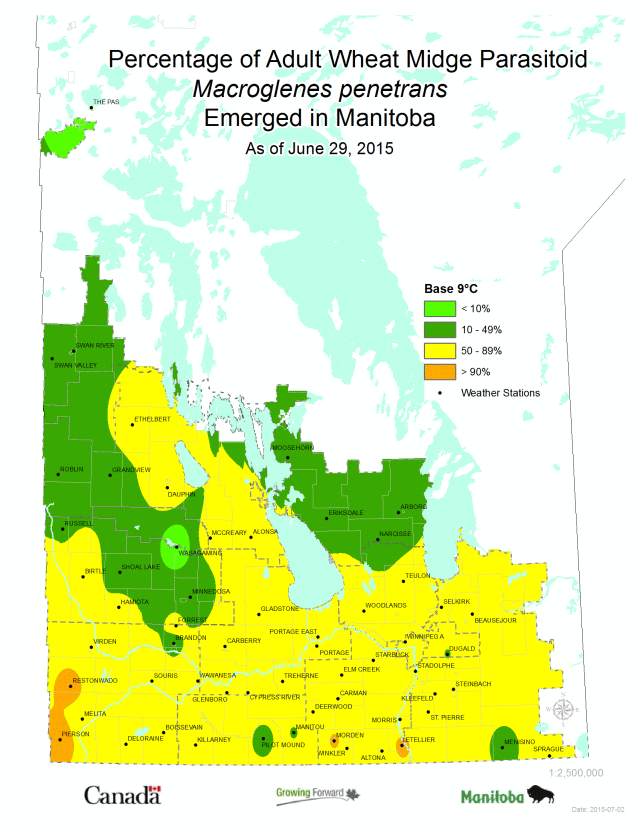Manitoba Insect & Disease Update: June 30, 2015
Summary
Scout cereal crops for rusts, and consider whether fusarium is a risk. Insects noted in cereal crops include armyworms and cereal leaf beetle, although not at economic levels. Insect populations are currently light in canola and oilseed crops. Some higher levels of alfalfa weevil are still present in the Interlake.
Cereal Crops
Stripe Rust in Spring Wheat: After the first reports of stripe rust and leaf rust in winter wheat the week of June 15th, there have been reports of stripe rust in several spring wheat fields in Southern Manitoba. To date, reports indicate low incidence within individual fields. Producers and agronomists should actively scout their spring wheat crops for all leaf diseases.

Figure 1: Stripe Rust in Spring Wheat, cvr Prosper, near Dominion City, MB.
Photo provide by Cameron Hildebrand
For spring wheat, many fields are near, or at, full flag leaf to heading stages. Depending on disease pressure, taking into consideration weather forecasts and resistant ratings of the variety (i.e. disease triangle!), producers may need to target a flag leaf timing for leaf disease management. Producers will then assess risk to determine if a fungicide timing at flowering is warranted for suppression of FHB.
Note: In Seed Manitoba 2015, the stripe rust resistance rating for Cardale spring wheat is listed as MR or moderately resistant. However, in discussion with Harpinder Randhawa, wheat breeder in Lethbridge, AB, two years of data indicates Cardale exhibits a susceptible reaction to stripe rust. Updates to the disease resistance rating will be made to all three Western Provincial Seed Guides in future editions.
Additionally, the spring wheat varieties Faller and Prosper (which are not listed in Seed Manitoba 2015) showed susceptible reactions to stripe rust through two years of testing in the variety registration system.
Fusarium Head Blight Risk Maps: Daily FHB Risk maps continue to be available Monday to Friday on MAFRD’s webpage at http://www.gov.mb.ca/agriculture/crops/seasonal-reports/fusarium-head-blight-report.html. Animation maps are also available compiling the daily risk maps over the previous 7 days showing how the risk has progressed. Producers are encouraged to continue scouting their fields to ensure proper fungicide timing if application is warranted.
Please note daily maps for Sunday and Saturday are created and posted Mondays at Archived 2015 Maps.
Armyworms: Armyworms are starting to be noticed in some cereal crops and forage grasses. Generally levels are not economical, but good to be scouting as some higher levels have been noted in the Central region. This is an insect that does not overwinter in Manitoba and blows in. So populations can vary from year to year and at times be quite localized. Populations can also vary greatly within a field, and tend to be higher in denser areas of a field (such as lodged areas, or where plant stands are higher). Note that this is not bertha armyworms (which overwinters in Manitoba and so far only low levels of adults have been detected).
Armyworms have quite general feeding habits but do tend to like grassy crops. When scouting cereal crops, have a look at the ground to see what potential armyworm populations may be like. And if you start seeing birds flocking to an area of a field, it may be a clue to look on the ground and see if armyworms are possibly present and at what levels. There are several nominal thresholds that have been suggested for armyworms in cereals; one that is often used is four unparasitized larvae, smaller than 2.5 cm (1 inch) per square foot.

Figure 2. Armyworm
Wheat Midge Emergence: Emergence of wheat midge, based on degree-day models, is currently less than 10%. So most of the emergence is yet to come and will likely happen in the second and third week in July. So any wheat that is already producing anthers, or heading out and close to producing anthers, should be at low risk of wheat midge damage. After the wheat heads produce anthers the wheat kernels are no longer susceptible to feeding by wheat midge. Note from the maps below that although wheat midge emergence is still less than 10%, its key parasitoid, Macroglenes penetrans, is further ahead in its emergence, so populations will be ready for wheat midge when it emerges.


Insect Monitoring Programs
Bertha Armyworm: Pheromone-baited traps are used to monitor adult moths of bertha armyworm, and forecast areas that potentially could have higher levels of larvae later in the summer. Traps were set up in early-June, and currently on very low levels of the adult moths have been detected. Anything under a cumulative count of 300 moths in the trapping period is considered low risk. Once counts get over 300 risk moves into an unpredictable risk zone, and much higher counts are needed to be in moderate and high risk categories. The highest count currently in Manitoba is 28 moths. Numbers will increase over the next few weeks, and we should know in the next couple of weeks whether there is likely to be higher risk of damaging larval populations in any areas.
Table 1. Highest Cumulative Counts of Adult Moths of Bertha Armyworm in Manitoba as of June 30, 2015
| Location | Region | Trap Count |
|---|---|---|
| Swan River | Valleys North | 28 |
| Carberry | Central Plains | 25 |
| Alexander | Southwest | 25 |
| Glenboro | Pembina | 22 |
| Morris | Red River | 18 |
| Washow Bay | North Interlake | 17 |
| Crystal City | Pembina | 15 |
Compiled by:
John Gavloski, Entomologist
Manitoba Agriculture, Food and Rural Development
Phone: (204) 745-5668 Fax: (204) 745-5690.
To report observations on insects or plant pathogens that may be of interest or importance to farmers and agronomists in Manitoba, please send messages to the above contact address.
To be placed on an E-mail list so you will be notified immediately when new Manitoba Insect and Disease Updates are posted, please contact John Gavloski at the address or numbers listed above.
Manitoba Insect & Disease Update: June 30, 2015
John Gavloski, Entomologist
Manitoba Agriculture, Food and Rural Development
Phone: (204) 745-5668 Fax: (204) 745-5690.
To report observations on insects or plant pathogens that may be of interest or importance to farmers and agronomists in Manitoba, please send messages to the above contact address.
To be placed on an E-mail list so you will be notified immediately when new Manitoba Insect and Disease Updates are posted, please contact John Gavloski at the address or numbers listed above.
Manitoba Insect & Disease Update: June 30, 2015

